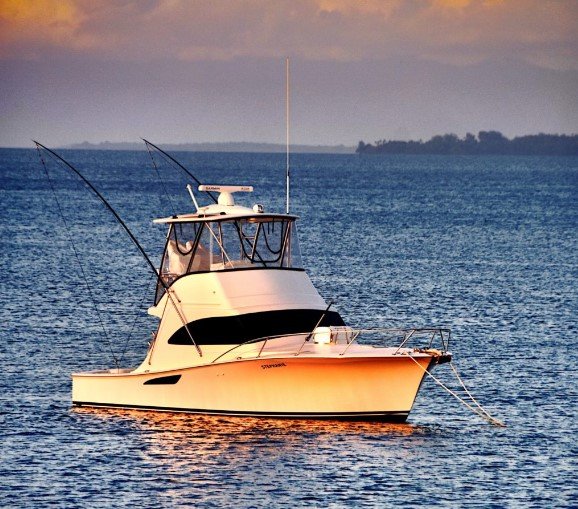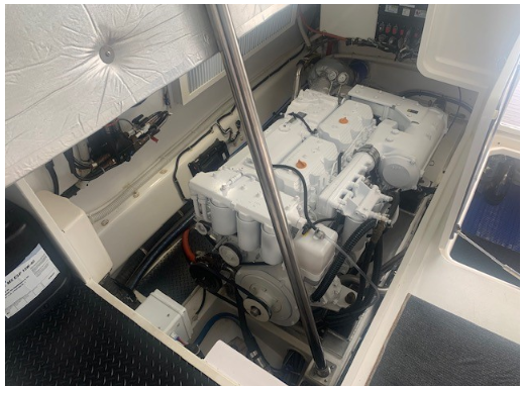Blue marlin, beer horns and Yanmar 6CXBM-GT engines!
Last updated: 15 Feb 2024 | 1214 Views |

Steve Philp has a serious thirst for a challenge. Among his other adventures, Steve has run the dive shop in Rabaul, (before the disastrous 1994 volcano eruption in the area), and dived on the wrecks of Japan’s WW2 Pacific fleet in over 200ft of water.
No fear of a serious challenge has paid off for Steve in a project which saw him help rebuild world-famous lure maker John Lau’s Viking 37 game boat with Yanmar diesels.
To understand just how big this particular repower challenge was, you need to go back a few years. Back to 2017 to be exact.
The Viking 37 ‘Stephanie’ was purchased brand new from the USA in 2017 and delivered via its Gold Coast dealer to Rabaul, PNG, where it was to serve its primary purpose as a game fishing vessel in the amazing fishing grounds in and around the Bismark Archipelago off New Britain, in eastern PNG.

Disaster struck early for this classic designed, compact flybridge game fishing vessel however. Via a series of misfortunes, she sank at her mooring. After recovery, the next year saw Stephanie sit ashore in a sorry and written-off state, wondering what was next.
“We looked at all the options of a brand new boat for John, but it was either just too hard to get one built or would take too long,” said Steve about the process of getting John and his marlin lures back on the water.
“So the hull was purchased off the insurance company with a plan to rebuild it,” he said.
“We weren’t happy with the structure of the vessel at all – basically we rebuilt the front section of the boat and strengthened the engine beds,” Steve explained.
“In fact, we re-built entire panels and structure on front parts of the boat and sorted out issues that we believe would have been allowing the hull to flex way too much in its original state.”
On top of significant hull and superstructure work, the electrics, refrigeration and air conditioning were all reconfigured. In all, around AUD$1m was spent on the restoration.
Steve is no newbie when it comes to boats, his family heritage is the famous Burns Philp shipping company that dominated shipping along the east coast of Australia and the South Pacific for decades from the late 19th Century. “I used an engineering firm I know well to fit the new engines and we made some changes with running gear also,” explained Steve.
While the Viking 37 originally came with American-branded 550hp engines, (the only option offered at the time by the builder), they opted for the dedicated marine propulsion option of Yanmar 6CXBM-GT 509mph engines for Stephanie’s new life.
“They’re a mechanical engine and that’s a good thing in remote areas like PNG,” says Steve. Steve is not alone with many leisure and commercial users who operate in remote areas preferring to opt for less electronic and digital technology in their engines. In fact, this is not the first time Steve has had experience with the 6CXBM-GT engine, having fitted them to a similar-sized game boat previously, with faultless service.
Other upgrades for Stephanie’s Yanmar refit included five-bladed props and strengthened Aquamet 22 survey-grade propeller shafts.
“We are also running gearboxes that can handle the horsepower of these engines (Twin Disc 5075A @ 2.05:1 ratio) so she is stronger right through in terms of running gear now.” Strength and reliability are the name of the game for Yanmar, yet this more robust propulsion regime has not come at the expense of performance according to Steve.
The Viking is achieving a nice run of 22 knots at 2000rpm, an even nicer 27 knots at 2,400rpm and 34 knots at WOT, (logged at 2780rpm in sea trials). Considering in her factory configuration with nearly 100 more horsepower the Viking 37 had a top speed of 34 knots, it’s no wonder that even Power Equipment’s Jim Kibblewhite was impressed with this repower. “Jim from Power Equipment came on the sea trials and he said it’s one of the best re-fits he’s ever seen,” Steve says proudly.
High-end cabinetry in the living areas of Stephanie and a reconfiguration of berths helps create a great new feel in the vessel too. Sticking with Yanmar reliability made the decision for generator power easy, with a Mase power plant supplied by Power Equipment completing the restoration.
All that remained after the hard work was the return trip to her home port of Rabaul. Steve was happy to take on that adventure too, “but I’ve done it plenty of times so we know what we’re doing with transferring a boat between Cairns and PNG,” says Steve.
Carrying around 1,600L of fuel and displacing 13t loaded, the Yanmars are throttled back to run the vessel at the nine-knot mark giving a 900 to 1000 nautical mile range.
“We’ll carry some extra fuel on the deck for safety, but even at those speeds you can’t run at night up there, there’s just too many logs and other stuff floating around to travel safely,” Steve says of his experience of these amazing waters.

Upon Stephanie’s return to Rabaul however, the fun can really start. “We love chasing blue marlin from the flybridge and spacious cockpit of this compact game boat…we usually run out at gentleman’s hours, 9am or later sometimes, and we’re usually enjoying a beer or two during the fishing.”
In fact, says Steve, there is even a dedicated “beer horn” on the flybridge; “One honk on the beer horn is the signal for the deckhand to bring one beer, two honks mean bring two beers and so on…” quips Steve.
Their preferred fishing grounds are about an hour’s run off Rabaul, past a chain of islands not far off shore, that provide water depths in excess of 2,000m and game fishing that many keen anglers could probably only dream of.
“I suppose John would put around 500 hours on the engines each year and I will do most of the servicing to be sure things get done. I’ll get our local Yanmar dealer Greg Sims from Cairns SIM Trans, (a Cairns-based local engine supplier and marine diesel expert), for the more technical servicing aspects though.”
Sounds like a good plan and certainly good fishing ahead Steve. Hoooonnnkkk!!!!



